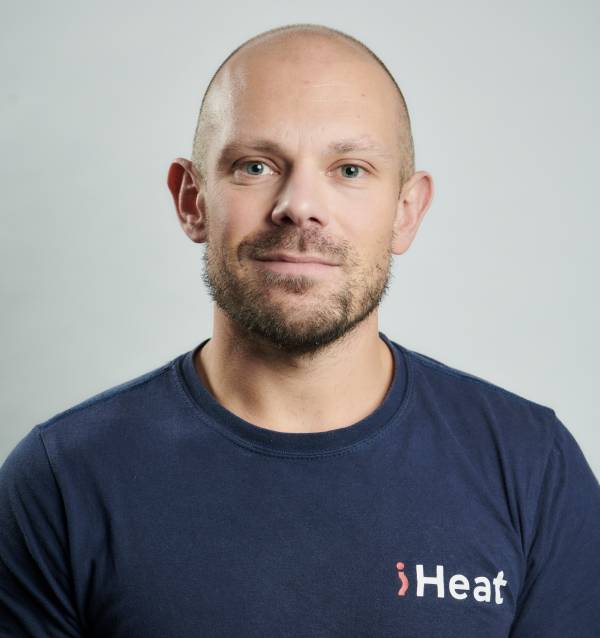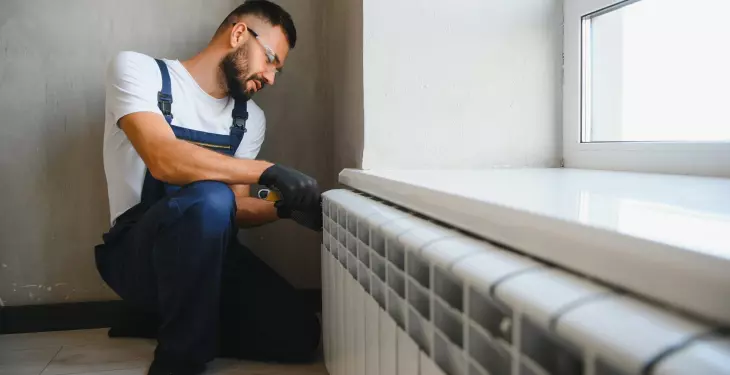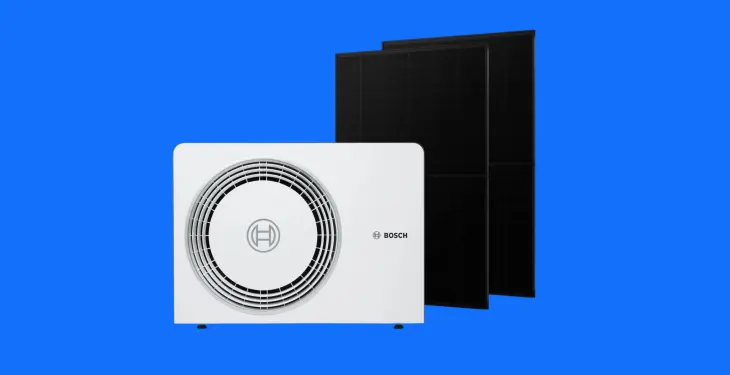

Written by Stephen Day
Gas Safe Engineer
Updated: 1st August, 2025
Setting the right temperature with an air source heat pump is important for comfort and efficiency. Most experts recommend keeping the thermostat between 18–21°C.
See how much you could save with a heat pump quote.
Air source heat pumps are becoming more common in UK homes, providing an energy-efficient way to heat and cool buildings. The most efficient way to run an air source heat pump is to set a steady temperature, use the weather compensation feature, and take advantage of off-peak electricity hours. This approach helps keep running costs low and maintains comfort throughout the year.
Choosing a qualified heat pump installer and following building regulations during installation also make a real difference. Government grants can also help with costs, making it easier for more people to benefit from this technology.
Setting the right temperature with an air source heat pump is important for comfort and efficiency. Most experts recommend keeping the thermostat between 18–21°C. This steady range helps the system work efficiently without sudden changes.
Modern heat pumps come with smart thermostats or controls. These allow users to make small adjustments—often by as little as 1–2 degrees—through a wall control or smart app. A slow, steady change puts less strain on the compressor and helps maintain the system’s health.
Heat pumps run best when left on for longer periods instead of being turned on and off frequently. The system uses a refrigerant to pull warmth from the air outside. Making constant changes to the temperature can cause the compressor to work harder and may affect the refrigerant level over time.
A simple way to manage temperature is to use a schedule:
Time | Recommended Setting |
Daytime (active) | 18–21°C |
Night (asleep) | 16–18°C |
Away | Lower by 2–3°C |
Regularly checking the heat pump’s controls and setting an appropriate schedule can help keep rooms comfortable and save energy. If the home feels too cold, increasing the temperature gradually is better than making a large change.
An air source heat pump works differently compared to traditional heating systems. For the best results, users should avoid turning it off completely and instead rely on the built-in controls to adjust the temperature as needed.
Controlling the temperature in each room is possible with an air source heat pump using multi-zone systems. These systems allow different parts of the house to be set to different temperatures, which helps prevent wasted energy in unused spaces.
One common method involves using multiple indoor units. Each unit is installed in a specific room or zone and can be controlled separately, often with its own remote or wall-mounted thermostat.
For homes using underfloor heating or radiators with a heat pump, thermostatic radiator valves (TRVs) or zoned controls can be used. This means each room can have its own set temperature, adjusted using the valve or a smart controller.
Many new systems now work with smart thermostats. These let users set schedules and control individual room temperatures from their phone or tablet. Some even learn usage patterns and adjust heating automatically.
Example Advantages:
Method | Control Level | Main Tool |
Multi-zone indoor units | High, room-by-room | Remote/Thermostat |
Thermostatic radiator valves | Medium, per radiator/room | Manual/Smart Valve |
Smart thermostat zones | High, flexible and remote | Phone/Tablet |
Making use of these controls not only improves comfort but also can help save energy. It means only the rooms being used are heated, so less energy is wasted.
Turning off radiators in rooms that are not being used seems like a simple way to save energy. Many people do this to reduce heating bills.
With an air source heat pump, the situation is a bit more complex. These systems work best when heating the whole house at a steady, low temperature. Shutting off radiators in some rooms may disrupt the system’s efficiency and could lead to uneven heating.
It is usually better to turn the radiator valves down rather than off completely. This keeps some warmth in unused rooms and prevents condensation or cold spots.
If rooms are left too cold, the temperature difference between rooms increases. This can cause warmth to leak into the cooler spaces, making the heat pump work harder.
Key points to consider:
Lowering radiator valves—not turning them off—helps keep room temperatures balanced.
Air source heat pumps perform well when heating is even throughout the home.
Very cold rooms could lead to damp or mould over time.
Table: Managing Radiators with a Heat Pump
Action | Effect |
Radiator valve fully off | Risk of cold, damp, less efficient system |
Radiator valve turned down | Saves some energy, keeps minimal warmth |
All radiators open | Balanced heating, higher overall energy use |
It’s always important to check guidance from your heat pump manufacturer. Every home is different, so adjustments may be necessary.
Using an air source heat pump to cool a home at night is straightforward. Most modern systems can switch between heating and cooling modes. The thermostat allows users to set the desired night-time temperature.
Steps to cool your home at night:
Switch to cooling mode: Ensure the heat pump is set to cooling, not heating.
Set a comfortable temperature: Aim for a temperature around 18–21°C.
Use a programmable thermostat: Schedule the cooling to start before bedtime and stop in the morning.
Close windows and curtains: Keep the cool air inside and block out external heat.
A simple table with settings to consider:
Setting | Recommendation |
Mode | Cooling |
Night Temp Set Point | 18–21°C |
Program Start Time | 30 min before bed |
Program End Time | Morning (wake up) |
Many heat pumps also allow fan-only mode, which can help circulate air without much energy use.
It is helpful to avoid heat build-up during the day. Keep curtains and blinds shut to reduce sunlight coming in. Appliances like ovens and dryers should be used earlier in the day if possible.
Some models have sleep mode, which gradually adjusts the temperature through the night. This can improve comfort and efficiency.
Service and maintenance matter as well. Filters should be clean so air flows easily and efficiently. Regular checks help the system perform at its best.
Turning off an air source heat pump is simple, but it’s important to do it correctly to avoid any issues.
Steps to turn off a typical heat pump:
Locate the control panel or thermostat.
Most modern heat pumps can be turned off using their digital controls.
Select the ‘off’ or ‘standby’ option.
On many systems, there will be a button or menu setting for turning the unit off or switching it to standby.
Wait for the system to power down.
The fan may continue for a minute after powering off.
Some models also have a dedicated power switch. This is usually found near the indoor unit or at the outdoor unit’s fuse box.
Safety tips:
Never turn off the heat pump by cutting the power at the mains unless instructed in the manual.
Always follow the manufacturer’s instructions for your specific model.
Below is a simple comparison table for turning off methods:
Method | When to Use | Notes |
Control panel/thermostat | Everyday use | Most recommended |
Power switch/fuse box | Maintenance or repairs | Use with caution |
Leaving the pump off for a short period does not save much energy. Turning it off for long periods, like holidays or maintenance, is appropriate.
If in doubt, check your user guide or contact the installer for help.
If a home becomes too hot in summer with an air source heat pump, there are some simple steps that can help. Many modern heat pumps can switch to a cooling mode, much like air conditioning. If this feature is available, set the heat pump to cooling to lower the indoor temperature.
It is important to ensure doors and windows are closed while cooling, as warm air from outside can make the unit work harder. Curtains or blinds should be closed during the day to block direct sunlight and reduce heat entering the home.
Managing humidity is also key. High humidity can make a room feel warmer, even if the temperature is not very high. Many air source heat pumps can help regulate humidity levels, making the space more comfortable.
If the heat pump does not have a cooling mode, other methods can help:
Use fans to create airflow
Open windows in the evening to let cool air in
Reduce the use of heat-producing appliances during the day
A table showing quick actions:
Action | Effect on Temperature |
Set heat pump to cooling mode | Lowers room temperature |
Close blinds/curtains | Blocks heat from sunlight |
Use fans | Circulates cool air |
Manage humidity | Improves comfort |
If the heat pump cannot cool the home enough, a portable air conditioning unit may sometimes be needed for extreme heat. However, this should only be used when necessary, as heat pumps are usually more energy-efficient.
Many notice that their radiators feel cooler after switching to an air source heat pump. This is expected and often means the system is working efficiently, not that it is faulty.
Traditional gas boilers heat water to much higher temperatures, sometimes up to 75°C. Air source heat pumps typically run at lower flow temperatures, between 35°C and 55°C. Lower flow temperatures increase efficiency and reduce running costs.
A lower flow temperature means the radiators are warm, not hot, to the touch. However, they can still keep a home comfortable because they run for longer periods. This helps maintain a steady indoor temperature.
Reasons radiators feel cooler with a heat pump:
Lower flow temperatures needed for higher Coefficient of Performance (COP)
Radiators designed to operate with warm, not hot, water
The system works best in well-insulated homes
Homes with poor insulation may not feel as warm. Upgrading insulation helps keep the heat inside, allowing the pump to work more efficiently.
Sometimes, radiators may need to be replaced with larger models or panels to deliver the same heat output at lower temperatures.
Boiler System | Typical Flow Temp | Radiator Surface Temp |
Gas Boiler | 70-75°C | Very hot |
Heat Pump | 35-55°C | Warm, not hot |
Modern control settings can also influence how warm radiators feel. Smart controls and proper balancing help get the best out of the system.
If there is a power cut, an air source heat pump will stop working straight away. This means there will be no heating or hot water until the power is restored.
During a power cut, it is best to keep windows and doors closed to help the home stay warm for as long as possible. Wearing extra layers or using blankets can help as well.
If the heat pump does not restart automatically after the power returns, try the following steps:
Check the main power switch to make sure it is on.
Reset the heat pump using the reset button or switch if there is one.
Inspect the settings to ensure they have not changed.
If the system still will not start, contact a qualified technician for advice.
Batteries or a UPS (Uninterruptible Power Supply) can help keep the heat pump running during short power cuts. These options may be especially useful for people in areas with frequent outages.
Regular servicing and maintenance can help avoid problems after power is restored. Keeping the system in good condition makes it more likely to restart smoothly after any power interruption.
Issue | What To Do |
Heat pump not turning on | Check power, reset system, call technician |
Loss of heat or hot water | Wear layers, keep doors closed |
Settings lost | Re-enter settings, consult user manual |
When using an air source heat pump in the UK, the ideal temperature for a hot water cylinder is typically between 55°C and 60°C. This range is recommended for efficiency and safety.
UK building regulations advise that hot water cylinders should reach at least 60°C regularly. Heating water to this level helps prevent bacteria like Legionella, which can grow at lower temperatures.
Running the hot water cylinder at a lower temperature, such as 50°C or 55°C, may save more energy, but it is important to schedule a regular “boost” to 60°C at least once a week.
Below is a simple table to help:
Temperature | Purpose |
50°C-55°C | Everyday energy-saving use |
60°C | Weekly safety boost (anti-legionella) |
Some heat pumps may include a built-in schedule to automatically raise the water temperature once a week. If not, this can be managed manually.
Most systems use an electric immersion heater to bring the hot water up to 60°C when needed. The air source heat pump usually heats the water cylinder to a lower, more efficient temperature during daily use.
Keeping the thermostat at a steady level supports both efficiency and performance. Rapid changes or frequent boosting can use more electricity. A consistent approach is best for both comfort and energy bills.
Proper insulation is key. Well-insulated homes keep more heat inside, so the air source heat pump does not have to work as hard. This reduces both running costs and energy bills.
Setting the heat pump to run at a lower temperature, but for longer periods, can use less electricity. Quick temperature jumps make the system work harder, cutting efficiency.
Creating zones in the home lets users only heat the rooms they need. This saves energy, especially in homes with several unused spaces.
Simple ways to save energy:
Close curtains at night to keep heat in
Regularly clean and service the heat pump
Set timers or smart controls for better use
The coefficient of performance (COP) shows how well the heat pump converts energy into heat. The higher the COP, the better the energy efficiency.
Adding solar panels is another step. They can power the air-source heat pump, lowering energy bills even further and helping work towards net zero.
A well-maintained air source heat pump reduces a household’s carbon footprint and keeps the home warm. Combining strong insulation, smart controls, and regular checks offers the best energy saving results.
Last updated: 1st August, 2025

Written by Stephen Day
Gas Safe Engineer at iHeat
Stephen Day is a Gas Safe registered and FGAS certified engineer with over 20 years of hands-on experience in the heating, cooling, and renewable energy industry, specialising in boiler installations, air conditioning, and heat pump systems.
LinkedInArticles by Stephen Day are reviewed by iHeat’s technical team to ensure accuracy and reliability.

05th December, 2025
Most homes need some radiators upgraded for a heat pump, but usually not all of them.
 Read Article
Read Article

05th December, 2025
Most homes can lower heating costs by combining air source heat pumps with solar panels.
 Read Article
Read Article

28th November, 2025
High temperature heat pumps work like boilers without needing radiators, but they cost mor...
 Read Article
Read Article
No obligation. Takes less than 60 seconds.